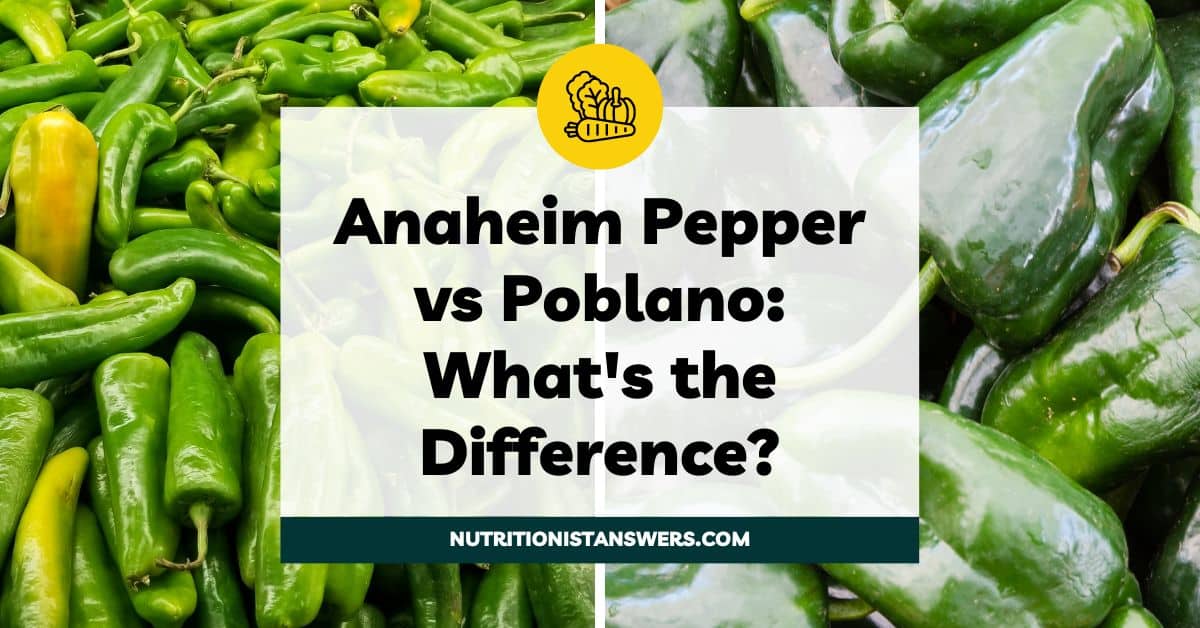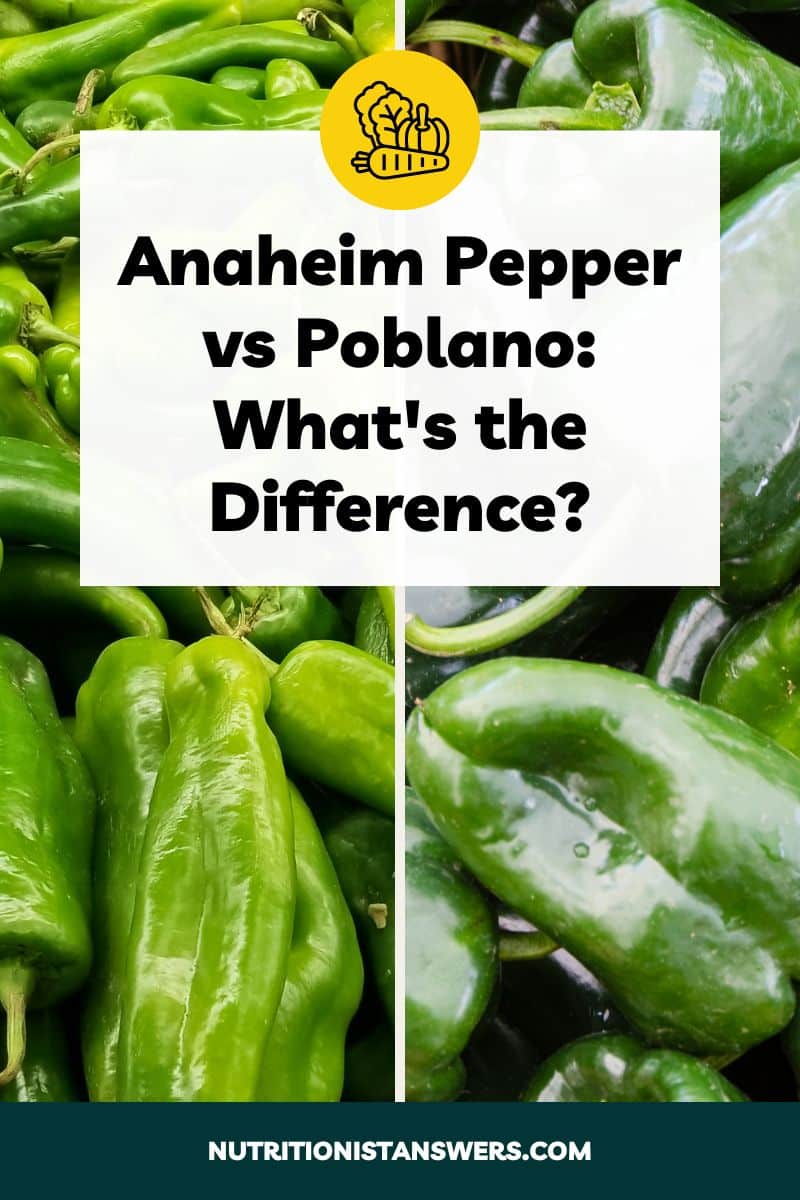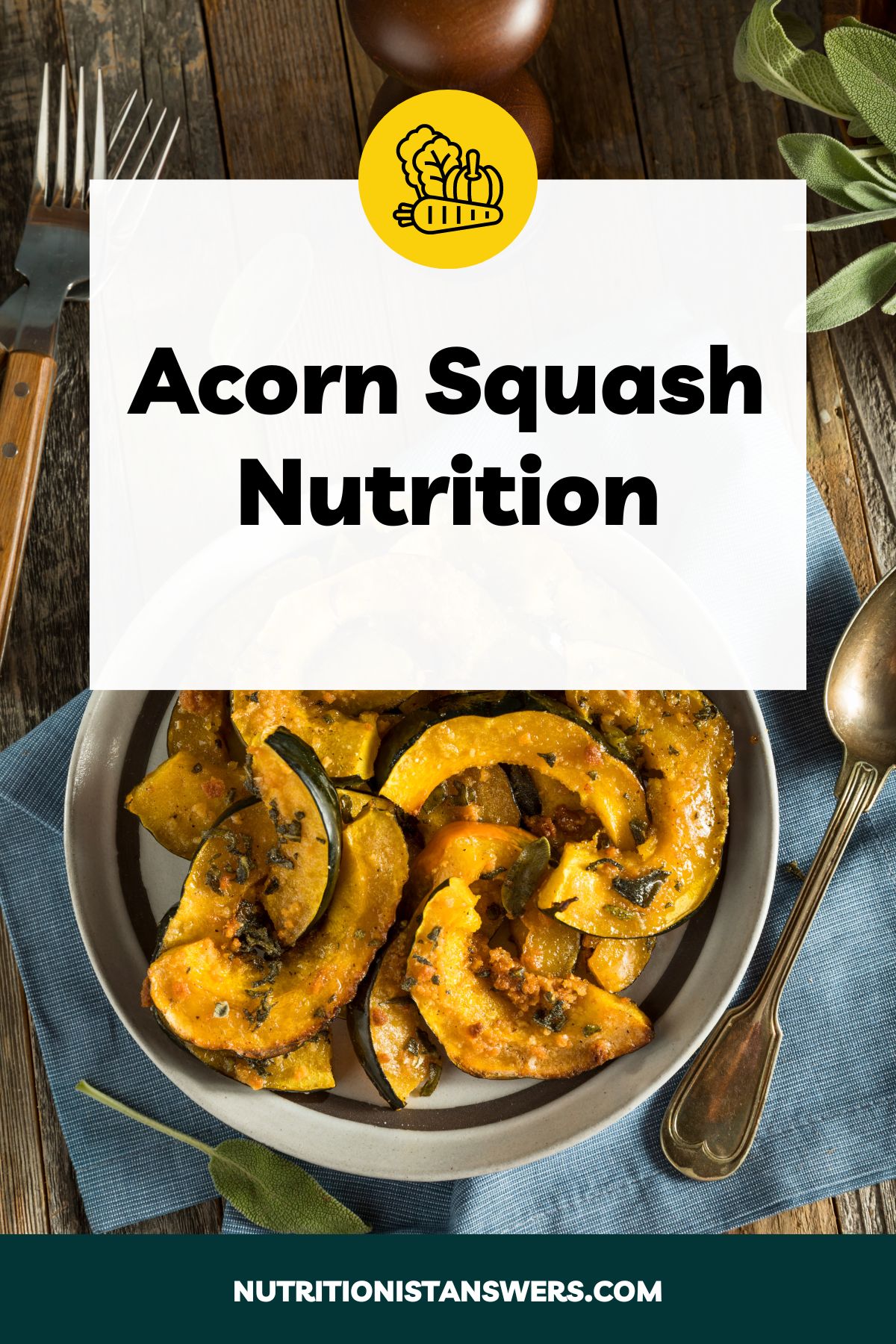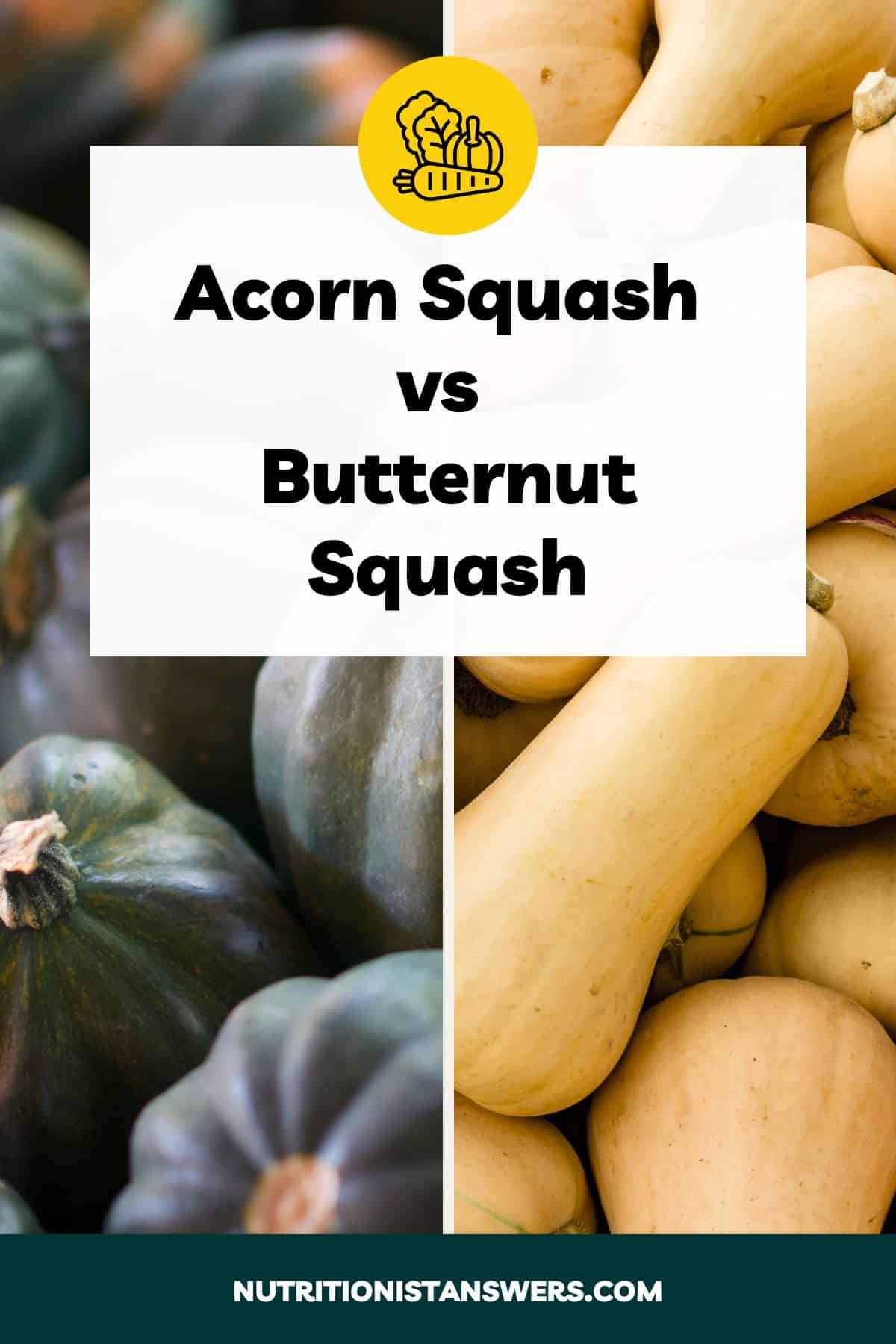Anaheim peppers and poblano peppers are two popular types of chile peppers used in cooking. You’ve probably seen them in many of the same recipes, like soups, chilis, and casseroles.
While these peppers have a lot of similarities, there are also some key differences that may influence how you use them.
In this article, we’ll compare Anaheim and poblano peppers, including their differences in flavor, heat level, nutrient content, available forms, and recommended uses.
Please note that this article contains affiliate links. If you click one of these links and make a purchase, we may earn a commission. As an Amazon Associate, we earn from qualifying purchases.

What are Anaheim peppers?
Anaheim peppers, named after a city in California, are mild chile peppers that are popular in Mexican and Southwestern cuisine.
These bright green peppers are long and slender, averaging 6 to 10 inches in length and 1 to 2 inches in diameter. They have a large cavity that’s perfect for stuffing with other ingredients.
Anaheim peppers taste sweet, peppery, and sometimes even a bit smoky. They have just a hint of spiciness, ranging from 500 to 2,500 SHU on the Scoville scale (1).
Fresh Anaheim peppers are sometimes available at supermarkets and Mexican grocery stores. The canned version can be found labeled as “canned green chiles” at most grocery stores.
Due to their mild flavor, Anaheim chiles are very versatile — they can add a hint of spiciness to soups, chilis, casseroles, dips, and more.
What are poblano peppers?
Poblano peppers are mild chiles that originated in the state of Puebla in Mexico.
They are dark green, thick-walled, and have an elongated heart shape, averaging 4 to 5 inches long and 2 to 3 inches wide.
Poblanos taste similar to bell peppers but with a richer, earthier flavor and a hint of smokiness. They measure 1,000 to 2,000 SHU, making them up to 8 times milder than jalapenos (1).
Fresh poblano peppers are widely available at many grocery stores and Latin food markets. Canned versions are less common but can sometimes be found in the canned foods aisle.
Poblanos are often used in Mexican and Southwestern cooking. They can be roasted, grilled, or stuffed and are the key ingredient in chile rellenos, a very popular Mexican dish.
Anaheim pepper vs poblano pepper
Anaheim peppers taste slightly sweeter than poblano peppers. Poblanos have an earthier, smokier flavor. Both peppers are very mild, each with a median SHU of 1500.
Like other green peppers, poblanos and Anaheim peppers are low in calories while providing a small amount of carbs and fiber. They’re also rich in vitamin C and provide good amounts of copper and vitamins B6, E, and K.
You can find fresh, dried, or canned versions of both peppers at many supermarkets and Latin grocery stores.
Both poblano and Anaheim peppers can be stuffed with other ingredients, or diced and added to condiments, marinades, soups, and casseroles. Because they’re so similar, one can easily be substituted for the other.
Here’s a more detailed review of how they compare in flavor, spiciness, nutrition, available forms, and recommended uses:
Flavor comparison
Poblano peppers and Anaheim peppers are both mild peppers with a hint of smokiness.
The key difference between the two is that poblanos have a richer, earthier flavor while Anaheim peppers taste sweet and peppery.
Because their flavor profiles are so similar, Anaheim and poblano peppers are commonly used as substitutes for each other in recipes.
Spiciness comparison
Both Anaheim peppers and poblano peppers are considered mild chiles.
On the Scoville scale, Anaheim peppers measure 500 to 2,500 SHU, while poblano peppers range from 1,000 to 2,000 SHU (1).
This means that poblano peppers have less variation in spiciness level, while Anaheim peppers have a wider variation.
So while most Anaheim peppers will be extremely mild, you might get a rogue somewhat-spicy pepper in your batch.
However, these small differences in heat level aren’t noticeable to most people.
Nutrition comparison
We couldn’t find enough information to fairly compare the nutrient content of Anaheim and poblano peppers.
In general though, peppers tend to have very similar nutrition because they all belong to the same species, Capsicum annuum (2).
Here’s an overview of the macronutrient content of a variety of green peppers, based on a 3.5-ounce (100-gram) serving (3, 4, 5):
| Nutrient | Assorted green peppers (bell peppers, jalapenos, and serranos) |
| Calories | 20-30 |
| Protein | 1-2 grams |
| Fat | <1 gram |
| Carbohydrates | 5-7 grams |
| Fiber | 2-4 grams |
| Sugars | 2-4 grams |
As you can see, green peppers (whether sweet or spicy) are very low in calories, protein, and fat. They also provide a small amount of carbohydrates, most of which are fiber.
Green peppers, like Anaheim and poblano peppers, are suitable for most diets, although they may need to be limited on very low-carb (ketogenic) diets.
Vitamins and minerals
Here’s an overview of the vitamin and mineral content of a variety of green peppers, based on a 3.5-ounce (100-gram) serving (3, 4, 5):
| Nutrient | Assorted green peppers (bell peppers, jalapenos, and serranos) |
| Vitamin A | 20-50 mcg RAE (2-6% DV) |
| Beta-carotene | 208-561 mcg |
| Alpha-carotene | 18-67 mcg |
| Lutein + zeaxanthin | 341-861 mcg |
| Vitamin B1 (Thiamin) | 0.04-0.05 mg (3-4% DV) |
| Vitamin B2 (Riboflavin) | 0.03-0.08 mg (2-6% DV) |
| Vitamin B3 (Niacin) | 0.5-1.5 mg (3-9% DV) |
| Vitamin B5 (Pantothenic acid) | 0.2-0.3 mg (4-6% DV) |
| Vitamin B6 (Pyridoxine) | 0.2-0.5 mg (12-29% DV) |
| Vitamin B9 (Folate) | 10-30 mcg (3-8% DV) |
| Vitamin B12 (Cobalamin) | 0 mcg (0% DV) |
| Vitamin C | 45-120 mg (50-133% DV) |
| Vitamin D | 0 mcg (0% DV) |
| Vitamin E | 0.4-3.6 mg (3-24% DV) |
| Vitamin K | 7-19 mcg (6-16% DV) |
| Sodium | 3-10 mg (<1% DV) |
| Potassium | 175-305 mg (4-6% DV) |
| Calcium | 10-12 mg (1% DV) |
| Phosphorus | 20-40 mg (2-3% DV) |
| Magnesium | 10-22 mg (2-5% DV) |
| Iron | 0.3-0.9 mg (2-5% DV) |
| Zinc | 0.1-0.3 mg (1-3% DV) |
| Copper | 0.05-0.13 mg (6-14% DV) |
| Manganese | 0.1-0.2 mg (4-9% DV) |
| Selenium | 0-0.4 mcg (0-1% DV) |
| Choline | 6-9 mg (1-2% DV) |
Green peppers are excellent sources of vitamin C, providing up to 120 mg (133% DV) in a 3.5-ounce (100-gram) serving. They’re also good sources of copper and vitamins B6, E, and K.
Keep in mind that dried peppers may have slightly lower levels of vitamin C and beta-carotene, which acts as an antioxidant and is used by the body to produce vitamin A (6, 7).
Likewise, cooking (especially boiling) can decrease the amounts of water-soluble vitamins, such as B vitamins and vitamin C (8).
Although beta-carotene often increases in vegetables like carrots when they are cooked, the same does not appear to be true for peppers (9, 10, 11).
Available forms
1. Fresh
Fresh poblano peppers are widely available. You can find them in the produce section at supermarkets, Latin grocery stores, and many farmers’ markets.
Anaheim peppers are also available in the produce section of many supermarkets, but they might be more challenging to find depending on your location.
Another option is to grow your own peppers. Both Anaheim and poblano peppers are fairly easy to grow indoors or outdoors in milder climates.
Can’t find fresh Anaheim peppers? Try one of these eight excellent Anaheim pepper substitutes.
2. Canned
Canned versions of Anaheim and poblano peppers are convenient for adding to sauces, dips, soups, and egg dishes.
These peppers are pre-roasted, peeled, and sometimes diced before being canned. They typically include salt and preservatives, such as calcium chloride and citric acid.
Anaheim peppers are often labeled simply as “diced green chiles” in cans. Occasionally, the ingredients list will identify them as Anaheim chiles, but not always.
Canned poblanos can be a bit trickier to find. Your best bet is to check your local Latin market or purchase them online. Poblanos are usually canned whole, rather than diced.
3. Dried
Both Anaheim and poblano peppers are picked before they’ve fully matured. Dried versions of these peppers are allowed to ripen to a vibrant red color before they are picked and processed.
When dried, poblano peppers are referred to as ancho chiles. They have a very dark red, almost black color and are known for their sweet, smoky flavor with notes of chocolate.
California chiles are the dried version of Anaheim peppers. They taste tangy and sweet with a touch of smokiness and have a beautiful dark burgundy color
Look for ancho and California chiles at supermarkets and Latin grocery stores, or consider purchasing them online. They are available in whole or powdered form.
Recommended uses
Anaheim pepper and poblano pepper can be used in many of the same ways.
1. Stuffed
Both Anaheim peppers and poblano peppers are the perfect size for stuffing with ingredients like meat, beans, rice, and cheese.
Poblano peppers have a slightly larger cavity that allows for more stuffing, making them ideal for dishes like chile relleno or these Southwest stuffed poblanos.
Anaheim peppers are long and skinny, so they don’t hold quite as much stuffing as poblanos. If using them as an entree, you’ll probably need to make at least 2 peppers for each person.
Due to their smaller size, Anaheim peppers also make great appetizers, like these bacon-wrapped stuffed Anaheim peppers.
2. In condiments & marinades
Fresh Anaheim and poblano peppers are perfect for adding a slight spiciness to salsas, relishes, and dips.
For even more flavor, try roasting them in the oven until they’re slightly charred. This will bring out their natural sweetness and boost their smoky flavor.
Dried versions of both peppers are best for adding depth and smokiness to sauces, such as mole and adobo sauce, as well as meat marinades for dishes like tacos al pastor and birria.
3. In soups, chilis, casseroles, and egg dishes
Fresh and canned Anaheim and poblano peppers can bring some much-needed flavor and spice to soups, chilis, and egg dishes.
Diced green chiles are a common ingredient in recipes like white chicken chili and tortilla soup, as well as white chicken enchiladas and green chile chicken casserole.
Canned or fresh, sauteed peppers are also an excellent addition to any egg dish, such as scrambled eggs, egg casseroles, and quiches
You can also add some ancho or California chile powder to your favorite chili recipe for an extra boost of flavor.
Final thoughts
Anaheim peppers and poblano peppers are both mildly spicy chiles. They have a similar flavor, but poblanos are rich and earthy, while Anaheim peppers are a little sweeter and more peppery.
Like other green peppers, poblanos and Anaheim peppers are low in calories, fat, and protein, while providing small amounts of carbs and fiber. They’re also rich in vitamins C, B6, and K, as well as copper.
Fresh, dried, and canned forms of both Anaheim and poblano peppers are available at many supermarkets and Latin grocery stores.
Both peppers are perfect for stuffing, but they can also be added to sauces, soups, chilis, casseroles, and egg dishes.
Amy Richter is a Registered Dietitian Nutritionist based in Missouri. She is an experienced nutrition writer and medical advisor for Healthline and Medical News Today. Amy is passionate about all things food-related and enjoys translating complex science into easy-to-understand articles.





